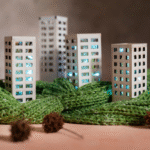Ashok John Oommen
Professor, TKMSA
Kerala is not just a narrow strip of land between the Western Ghats and the Arabian Sea. It has always been a place where history, cultures, climates, and communities have all made their mark—expressed through its architecture and the ongoing efforts at architectural heritage conservation.
When you walk through the streets of the cities, the temple towns, the villages, the lowlands of Kuttanad, or the misty hills of the Western Ghats, you will always find evidence of living heritage—aaltharas, agraharams, ghats, nalukettu homes shaded by fruit trees, traditional tharavadu complexes, palaces, temples, churches, mosques, and synagogues—each telling a story of architectural heritage conservation and preservation.
Regional variations of the traditional pitched timber roofs of Kerala, colonial structures, and old railway stations—all held up by time, memory, and the spirit of preservation in architecture.
Read: Architecture of Kerala: How It Evolved Over the Years?
But this heritage is at risk.
As architects, we see how fast these structures disappear—swallowed by unchecked development, altered beyond recognition, or left to decay because “modern” seems more desirable.
The central part of the town of Kollam is a classic example of how such development has led to the loss of a lot of heritage buildings—the old railway station and the old buildings in its vicinity—some pulled down, some in neglect, and some under never-ending legal issues.
Yet, within these structures lie untold stories, design wisdom, architectural skill and craftsmanship, and a sense of place that newer buildings often struggle to replicate. This is why architectural heritage conservation becomes not just relevant but essential—to protect what remains before it vanishes entirely.
As students of architecture in Kerala, you have a rare and urgent opportunity—not just to admire these spaces, but to become active participants in their protection. You can start architectural heritage conservation—not by campaigning, but by carefully observing; not by intervening, but by documenting.
Read: Top Home Architecture Trends in Kerala: All You Should Know in 2025
Architectural Preservation Step One: Identification and Documentation
The first act of protection is knowing what exists.
Start in your own town or village. Visit old neighborhoods to acquaint yourself with structures that need architectural heritage conservation and preservation.
Walk. Talk. Sketch. Photograph. Measure. Ask questions.
Look for structures that may be:
- Vernacular (like nalukettu, ettukettu homes, temples, mosques, churches, agraharams)
- Colonial (Dutch, Portuguese, British residences, warehouses, schools)
- Modern heritage (pre-1970s buildings, cinemas, railway stations, public housing)
- Urban ensembles (market streets, temple squares, waterfronts)
For each building, prepare:
- A site plan and measured drawings
- Notes on materials, construction techniques, and climate response
- Current use, transformation over time
- Stories from local users or caretakers
- Sketches that capture ambience and spatial character
Don’t worry if your documentation isn’t perfect. What matters is that you start creating a record before it’s too late for architectural heritage conservation.
Architectural Preservation Step Two: Interpret and Understand
Documentation is only the beginning.
Ask:
- What can we learn from these structures?
- How do they adapt to climate? How do they negotiate community and privacy?
- What is the cultural and social significance of their layout and ornament?
Interpret the building as a system of people, materials, rituals, and space.
This step builds your critical thinking and prepares you to design more sensitively.
Step Three: Engage with the Community
Real architectural heritage conservation happens when communities care.
Try these:
- Organize heritage walks for school students or residents
- Create exhibitions in local libraries or panchayat halls
- Collaborate with NGOs, tourism boards, or local artists
- Collect oral histories from elders—how spaces were used, what traditions lived in them
Your work can revive community pride and foster intergenerational dialogue to conserve heritage.
Step Four: Propose and Advocate for Architectural Heritage Conservation and Preservation
Once you’ve understood a building’s value, you can start imagining futures for it.
Could a crumbling chavadi become a reading room?
Could an unused kalithattu be used again for social gatherings?
Could an old market street become a pedestrian heritage corridor?
Could a disused railway building become a student cultural hub?
Even small proposals matter in architectural heritage conservation. Prepare reports with your ideas, design alternatives, and visual material.
Submit them to local heritage committees or share them with community leaders.
Step Five: Design with Memory
Finally, bring your heritage experiences into the studio.
- Use vernacular principles in your climate-sensitive design studios.
- Explore adaptive reuse as a real-world design challenge.
- Study how modern materials can meet traditional forms meaningfully.
Learning from heritage is not about mimicking style—it’s about absorbing principles, values, and relationships that shape good design.
Read: Developing Design Concepts in Architecture: Tips and Tricks for Architecture Students
Conclusion: A Personal and Professional Commitment to Architectural Heritage Conservation
Architecture is not only about creating the new. It’s also about caring for the old, about reading the layers of time, and designing with empathy for people and places. In Kerala, our heritage is not behind glass walls—it is around us, lived in and worn, often ignored but never silent.
As a teacher, I believe that each of you can be a guardian of this legacy.
Start your architectural heritage conservation and preservation by choosing one building. One street. One story.
Sketch it. Know it. Share it.
That is where conservation begins.
Also read:




